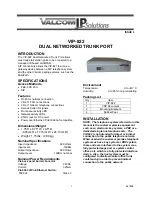
1-35
Loop guard
A switch maintains the states of the root port and other blocked ports by receiving and processing
BPDUs from the upstream switch. These BPDUs may get lost because of network congestions or
unidirectional link failures. If a switch does not receive BPDUs from the upstream switch for certain
period, the switch selects a new root port; the original root port becomes a designated port; and the
blocked ports turns to the forwarding state. This may cause loops in the network.
The loop guard function suppresses loops. With this function enabled, if link congestions or
unidirectional link failures occur, both the root port and the blocked ports become designated ports and
turn to the discarding state. In this case, they stop forwarding packets, and thereby loops can be
prevented.
With the loop guard function enabled, the root guard function and the edge port configuration are
mutually exclusive.
TC-BPDU attack guard
Normally, a switch removes its MAC address table and ARP entries upon receiving TC-BPDUs. If a
malicious user sends a large amount of TC-BPDUs to a switch in a short period, the switch may be busy
in removing the MAC address table and ARP entries, which may affect spanning tree calculation,
occupy large amount of bandwidth and increase switch CPU utilization.
With the TC-BPDU attack guard function enabled, a switch performs a removing operation upon
receiving a TC-BPDU and triggers a timer (set to 10 seconds by default) at the same time. Before the
timer expires, the switch only performs the removing operation for limited times (up to six times by
default) regardless of the number of the TC-BPDUs it receives. Such a mechanism prevents a switch
from being busy in removing the MAC address table and ARP entries.
You can use the
stp tc-protection threshold
command to set the maximum times for a switch to
remove the MAC address table and ARP entries in a specific period. When the number of the
TC-BPDUs received within a period is less than the maximum times, the switch performs a removing
operation upon receiving a TC-BPDU. After the number of the TC-BPDUs received reaches the
maximum times, the switch stops performing the removing operation. For example, if you set the
maximum times for a switch to remove the MAC address table and ARP entries to 100 and the switch
receives 200 TC-BPDUs in the period, the switch removes the MAC address table and ARP entries for
only 100 times within the period.
BPDU dropping
In a STP-enabled network, some users may send BPDU packets to the switch continuously in order to
destroy the network. When a switch receives the BPDU packets, it will forward them to other switches.
As a result, STP calculation is performed repeatedly, which may occupy too much CPU of the switches
or cause errors in the protocol state of the BPDU packets.
In order to avoid this problem, you can enable BPDU dropping on Ethernet ports. Once the function is
enabled on a port, the port will not receive or forward any BPDU packets. In this way, the switch is
protected against the BPDU packet attacks so that the STP calculation is assured to be right.
Содержание Switch 4800G PWR 24-Port
Страница 165: ...1 8 4 mac address es found on port GigabitEthernet1 0 2 ...
Страница 214: ...ii Displaying and Maintaining System Guard 4 1 ...
Страница 445: ...ii ...
Страница 727: ...i Table of Contents Appendix A Acronyms A 1 ...
Страница 730: ...A 3 VOD Video On Demand W WRR Weighted Round Robin X XID eXchange Identification XRN eXpandable Resilient Networking ...
















































